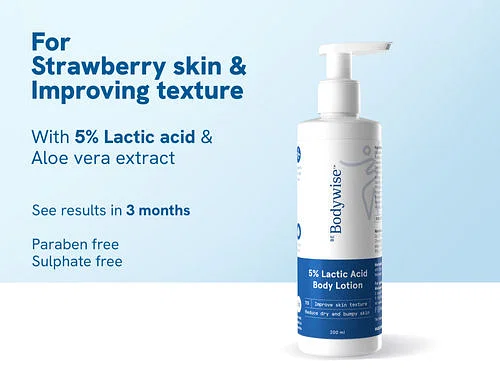
Can 5% Lactic Acid be used on the body?
Lactic acid is a chemical peel with a long and slightly gaudy history. Queen Cleopatra is known to have bathed in sour yak milk and honey to keep her skin youthful, soft and radiant.
Lactic acid has continued to rise in popularity over the centuries. Many product formulas often contain AHAs because it can produce impressive skin results while being gentle on the skin. However, as with all acids, its percentage plays a major role in its effect on the skin. With this in mind, we can now take a closer look at whether 5% lactic acid can be used on the body. Stay tuned if you want us to figure this out for you, but before we get started, let’s quickly review what lactic acid is and how it benefits the skin.
What is Lactic Acid?
Derived from fermented carbohydrates found in milk, lactic acid is one of the gentlest acids in the broad alpha hydroxy acid (AHA) family. As a water-soluble skin ingredient, lactic acid absorbs quickly to provide balance and moisture to dry skin. This unique property gives the acid a distinct advantage over similar products such as the popular glycolic and salicylic acids.
In over-the-counter formulas, you’ll often notice a 5% to 10% difference in lactic acid concentration. For professional use, you’d expect a percentage of more than 30, which is often seen in chemical peels or facials. Stronger concentrations don’t produce faster, more effective results. Finding the best formula really depends on how your skin accepts the product and whether you see results. Remember, everyone’s skin is different. So when you find a product that works for you, stick with it and reap the rewards.
Lactic acid has many benefits for the skin. Here are some of the most important ones that many people appreciate, such as:
Increases skin cell turnover and removes layers of dead skin cells that build up over time and can make the complexion appear dull.
May help reduce the appearance of fine lines and wrinkles by stimulating collagen production. This makes the skin look plumper and feel firmer.
Can remove bacteria, dirt, debris, and excess sebum that clog pores.
It works similarly to a moisturizer, meaning it attracts moisture around the skin and locks it in place.
Many people with dry, sensitive skin types love it because the large molecule size prevents the acid from penetrating too deeply into the skin.
Improves the skin’s natural moisturizing factor, helping to lock moisture into the skin barrier to keep it healthy and functioning properly.
Fights hyperpigmentation, dark spots, sun damage, and age spots.
Known as a highly effective ingredient in fighting pilaris catarrh. This is a skin condition that manifests as small bumps that appear on the surface of the skin that resemble “chicken skin.”
Used as an effective topical treatment for fighting psoriasis, rosacea, and eczema.
Although lactic acid is gentle on the skin, it’s important to remember that it’s still an exfoliant, which means there’s an increased risk of sun sensitivity. Because new skin cells are constantly appearing on the surface, the skin is more susceptible to sunburn from even mild UV exposure. Applying an SPF 30 or higher daily can prevent sunburn and sun damage.
You’ll also find that lactic acid can cause some minor skin irritation, such as redness, burning sensations, flaking, dryness, and itchy skin. These are rare and should be kept mild. However, if they become increasingly irritating or painful, you need to see a doctor or healthcare professional.
Can I use lactic acid on my body?
Yes, you can definitely use lactic acid on your body. Since it is very gentle, you can safely apply it to your body while avoiding unnecessary irritation.
Ideally, you should avoid applying lactic acid to cuts or open wounds, as this can sting and cause further irritation. You often find that the skin on your body is often forgotten, even though it needs light exfoliation just like your face. By using a body lotion enriched with lactic acid, you can remove all the dead skin cells, dirt, debris, and other impurities that have settled on the surface of your skin. This is considered to be the most effective formula for fighting acne breakouts on the chest, back, and shoulders.
What does 5% lactic acid do for your skin?
You will rarely find lactic acid in over-the-counter skin care products that contain more than 5%. This is because these formulas are designed to be applied to the skin twice a day. The result is plumper, firmer, and thicker skin without the worry of irritation and side effects caused by overuse of the acid.
If you want to use a higher percentage of lactic acid, chemical peels are the best results for you. Make sure you find the right beauty professional to perform the exfoliation as this will help you achieve your skin goals without irritation, redness and rashes.
Is 5% Lactic Acid Strong?
Yes, 5% lactic acid is strong and can be very effective for people with dry skin who cannot use other stronger acids such as glycolic acid. However, lactic acid is suitable for all skin types, especially with the added benefit of moisturizing the skin at the same time. One of the most common skin mistakes made by people with oily skin is using a higher concentration of exfoliating acid.
This often results in the skin being stripped of sebum, leading to excessive oil production, which can cause acne, clogged pores and blackheads. If you have oily skin, strong acids are not good for your skin and you can exfoliate with lactic acid without the side effects.
That’s it, more about lactic acid and whether you can use 5% lactic acid on your body. Don’t forget to visit us on Instagram if you have any other questions.


